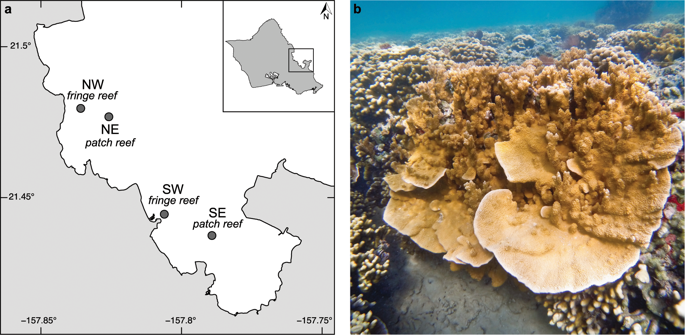Our official English website, www.x-mol.net, welcomes your
feedback! (Note: you will need to create a separate account there.)
Divergent symbiont communities determine the physiology and nutrition of a reef coral across a light-availability gradient.
The ISME Journal ( IF 10.8 ) Pub Date : 2020-01-03 , DOI: 10.1038/s41396-019-0570-1 Christopher B Wall 1, 2 , Mario Kaluhiokalani 1 , Brian N Popp 3 , Megan J Donahue 1 , Ruth D Gates 1
The ISME Journal ( IF 10.8 ) Pub Date : 2020-01-03 , DOI: 10.1038/s41396-019-0570-1 Christopher B Wall 1, 2 , Mario Kaluhiokalani 1 , Brian N Popp 3 , Megan J Donahue 1 , Ruth D Gates 1
Affiliation

|
Reef corals are mixotrophic organisms relying on symbiont-derived photoautotrophy and water column heterotrophy. Coral endosymbionts (Family: Symbiodiniaceae), while typically considered mutualists, display a range of species-specific and environmentally mediated opportunism in their interactions with coral hosts, potentially requiring corals to rely more on heterotrophy to avoid declines in performance. To test the influence of symbiont communities on coral physiology (tissue biomass, symbiont density, photopigmentation) and nutrition (δ13C, δ15N), we sampled Montipora capitata colonies dominated by a specialist symbiont Cladocopium spp. or a putative opportunist Durusdinium glynnii (hereafter, C- or D-colonies) from Kāne'ohe Bay, Hawai'i, across gradients in photosynthetically active radiation (PAR) during summer and winter. We report for the first time that isotope values of reef corals are influenced by Symbiodiniaceae communities, indicative of different autotrophic capacities among symbiont species. D-colonies had on average 56% higher symbiont densities, but lower photopigments per symbiont cell and consistently lower δ13C values in host and symbiont tissues; this pattern in isotope values is consistent with lower symbiont carbon assimilation and translocation to the host. Neither C- nor D-colonies showed signs of greater heterotrophy or nutritional plasticity; instead changes in δ13C values were driven by PAR availability and photoacclimation attributes that differed between symbiont communities. Together, these results reveal Symbiodiniaceae functional diversity produces distinct holobionts with different capacities for autotrophic nutrition, and energy tradeoffs from associating with opportunist symbionts are not met with increased heterotrophy.
中文翻译:

不同的共生生物群落决定了光利用率梯度上珊瑚礁的生理和营养。
珊瑚礁珊瑚是混养生物,依靠共生生物产生光致自养和水柱异养。珊瑚共生菌(家族:共生植物)虽然通常被认为是共生主义者,但在与珊瑚宿主的相互作用中表现出一系列特定物种的和环境介导的机会主义,可能要求珊瑚更多地依靠异养性来避免性能下降。为了测试共生菌群落对珊瑚生理(组织生物量,共生菌密度,光致色素沉着)和营养(δ13C,δ15N)的影响,我们采样了由专业共生Cladocopium spp占优势的Montipora capitata菌落。或来自夏威夷州卡内奥赫湾的假定机会主义者杜伦丁氏菌(Durusdinium glynnii)(以下称为C或D殖民地)在夏季和冬季的光合作用活性辐射(PAR)梯度范围内。我们首次报告珊瑚礁的同位素值受共生菌科群落的影响,这表明共生物种之间的自养能力不同。D菌落的共生体密度平均提高了56%,但每个共生体细胞的色素减少,并且宿主和共生体组织中的δ13C值始终较低;同位素值的这种模式与较低的共生碳同化率和向宿主的转运一致。C-和D-菌落均未显示出更大的异养性或营养可塑性的迹象。相反,δ13C值的变化是由共生生物群落之间的PAR可用性和光适应属性驱动的。综合起来,这些结果表明共生植物的功能多样性产生了具有不同自养营养能力的独特的全生命生物,
更新日期:2020-01-17
中文翻译:

不同的共生生物群落决定了光利用率梯度上珊瑚礁的生理和营养。
珊瑚礁珊瑚是混养生物,依靠共生生物产生光致自养和水柱异养。珊瑚共生菌(家族:共生植物)虽然通常被认为是共生主义者,但在与珊瑚宿主的相互作用中表现出一系列特定物种的和环境介导的机会主义,可能要求珊瑚更多地依靠异养性来避免性能下降。为了测试共生菌群落对珊瑚生理(组织生物量,共生菌密度,光致色素沉着)和营养(δ13C,δ15N)的影响,我们采样了由专业共生Cladocopium spp占优势的Montipora capitata菌落。或来自夏威夷州卡内奥赫湾的假定机会主义者杜伦丁氏菌(Durusdinium glynnii)(以下称为C或D殖民地)在夏季和冬季的光合作用活性辐射(PAR)梯度范围内。我们首次报告珊瑚礁的同位素值受共生菌科群落的影响,这表明共生物种之间的自养能力不同。D菌落的共生体密度平均提高了56%,但每个共生体细胞的色素减少,并且宿主和共生体组织中的δ13C值始终较低;同位素值的这种模式与较低的共生碳同化率和向宿主的转运一致。C-和D-菌落均未显示出更大的异养性或营养可塑性的迹象。相反,δ13C值的变化是由共生生物群落之间的PAR可用性和光适应属性驱动的。综合起来,这些结果表明共生植物的功能多样性产生了具有不同自养营养能力的独特的全生命生物,









































 京公网安备 11010802027423号
京公网安备 11010802027423号